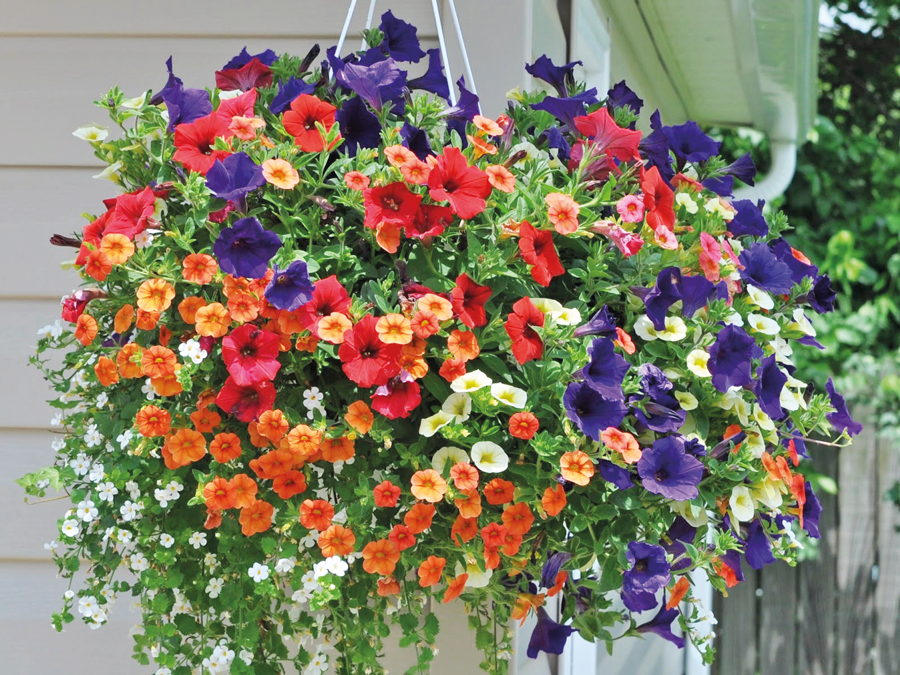May is the month when everything is growing at an alarming rate, and the list of ‘Things to do in the garden’ seems never ending. Having said that I can always find jobs to do in the garden any time of the year.
Pre planted hanging baskets are increasingly available from nurseries and garden centres and are great if you prefer an instant display or don’t have anywhere to grow a newly planted basket on for a few weeks. We should be over the worst of the weather and night frosts are hopefully behind us, but I have seen tender plants damaged by very cold nights especially where the wind is a little fierce. When buying pre planted hanging baskets or containers take note of where they are in the nursery or garden centre, sometimes they wheel them inside at night. Check for signs of stress or leaf damage on the outer edges of the leaves. if they look limp, dry or distorted they could be suffering from wind or frost damage.

I prefer to plant my own hanging baskets for a number of reasons, I get to choose the plants and colour scheme, I know what compost, fertiliser or additives have been used and can give them a little more attention as they establish. Admittedly I do have a greenhouse but it is not heated, so if the weather forecast predicts a particularly cold night I nip out and drape horticultural fleece over the whole basket. I won’t put the basket out until the first week in June, which may seem a little late but will almost guarantee it won’t be damaged by frost and it will flower on into October if looked after carefully. I like to use quite large baskets, as they can hold more plants, more compost and don’t dry out as quickly. Watering is probably the most frustrating issue, that is unless you have an automatic watering system. I have a few tricks to help the basket hold water for longer, my grandfather used to place a piece of turf in the bottom of the basket (green side down) which acts as a sponge, I have used a plant pot saucer in the bottom of the basket which will hold a small amount or water. Both these options are used after the liner has been placed in the bottom of the basket and are then covered with compost. Which brings me to the lining material, traditionally sphagnum moss was used as a lining material but there are wool substitutes available now which handle the same but are more environmentally friendly. For the compost I use a multipurpose type, the same as I would use for potting plants. Loam based composts can make the baskets and containers quite heavy. I don’t use water absorbing gel as is stays in the compost for years after. A friend asked If I knew what this jelly like substance was appearing around her Roses, and apparently she had emptied the old hanging basket onto the compost heap and subsequently used the compost to mulch around the roses. The jelly was the granules from the hanging basket still doing their job! As for fertiliser, many pre planted baskets have slow release granules added which are supposed to last a few months however if the weather is particularly warm and you are watering once or twice a day they don’t last as long. I usually add a small quantity of organic fertiliser to the compost at planting time then water with a general liquid fertiliser every week. If you inadvertently forget to water for a few days and find the compost difficult to re wet then just put a couple of drops of washing up liquid in the watering can, this will help the compost hold the water.
Finally make sure you pick off all faded flowers, this will encourage the plant to continue to produce flowers.
I love herbaceous perennials but I must admit some are somewhat straggly and flop over the edge of the path and lawn. Many of the more vigorous, such as Heleniums, Phlox(Border), Anthemis and Echinacea produce lots of growth and can collapse in exposed sites. Around the end of May cut the plants back by about a third and they will quickly bulk up and make stronger plants, flowering about two weeks later than normal, known as the ‘Chelsea Chop’ this is a very effective way of stiffening them up. Sadly this practice still requires the use of plant supports but will give sturdy growth and more flowers.
Keep an eye on soft fruit this month as dry spells can severely effect fruit production. Water well in dry spells and keep an eye out for pests and diseases which can also severely damage crops. If you survive the drought and manage to stave off pests and diseases, don’t forget that as the fruit reaches its peak it will be most attractive to birds. Placing a suitable net or cage over the whole bush will ensure that you will hopefully enjoy the fruits of your labours.
Next month, Visiting gardens, sowing for continuous crops and pruning spring flowering shrubs.
Happy Gardening
Martin
GARDENING Q&A
The question this month is from Emma, She wants to introduce gardening to her 2 children 5&8yrs. She is asking ‘which veg are easy and quick to grow and will hopefully encourage them to eat their healthy fresh produce’.
A great question and one that has proved quite challenging for many generations of parents. Choosing vegetables that will not only keep a young persons attention but are tasty too is the key. There are some that are quite attractive, like rainbow coloured radishes ready in about four or five weeks, but the taste is not always attractive to children. Likewise spring onions are ready to eat in about five to six weeks but again the flavour is still quite strong.
I think the first thing is to start with growing salad crops in containers, this seems to be more attractive to children as they can be moved around and grouped together to make a mini garden. Growing vegetables in potting compost rather than soil means that they will grow quickly and are less affected by pests and diseases. Start with salad crops such as lettuce and carrots – choose varieties that are bred for patio gardening, they are smaller and mature in less time than open ground traditional varieties. Try to make them trendy too, the increased use of ‘Mini’ veg and micro greens is popular with chefs today and ‘micro greens’ most of which are salad leaves like Lettuce and Rocket although you can grow some of the cabbage family like Kale and Broccoli, or herbs like Basil and Coriander. You can buy growing kits, with plastic trays, felt growing mat and a clear plastic top just like a mini greenhouse, to grow on a windowsill so they can watch them grow. There are many seed merchants on the internet, just type in ‘Growing micro vegetables UK’ The great thing about micro veg is that it is ready to eat in 10 to 14 days, tasty in sandwiches or just eaten as they are.

■ Yorkshire Reporter mini tots enjoying gardening.
Image © Yorkshire Reporter
My advice is to start them off with these and at the same time sow some patio veg and grow them in pots. Use multi purpose compost and choose a small corner of the patio that can be the children’s garden.
In terms of choice then you probably know best which your children prefer but I think that leafy Lettuce, salad carrots and mini peas are the most tasty. Lettuce ‘Little Gem’ is available in plain green or dark red, Choose a quick maturing bunching carrot like ‘Nantes 2 Early’ and for peas there are ‘Sugar Snap’ ( Cascadia or Sugar Anne), ‘Mangetout’ ( Oregon Sugar Pod or Reuzensuiker), or what I call poddy peas, try Half Pint or Tom Thumb. The Poddy peas will only grow to about 30cm (12 inches) and whilst there may not be enough to fill a pan, I think eating them straight from the pod or mixed with salads is the best way to enjoy them.
If you have a greenhouse, then try a snack or mini cucumber, my daughter used to love cucumber and especially those that are bite sized. At this time of year it is best to buy a plant from a nursery or garden centre, along with a grow bag. Stand the grow bag on its end, shake the bag so that the compost settles to one end then stand it up. Cut about two inches (5 cms) off the top and roll the top down to about 4 inches (10cms) from the compost. Plant the cucumber in the middle (just one) then push a garden cane in the compost at the side of the plant and tie it to the greenhouse roof for support. Feed with a liquid fertiliser every two weeks and enjoy. Varieties to try are ‘Mini Munch’, ’Cucino’ or ‘Snacker’.
Get your children started in the garden with this month’s competition to win three packets of seeds.
To enter go to the competition page







